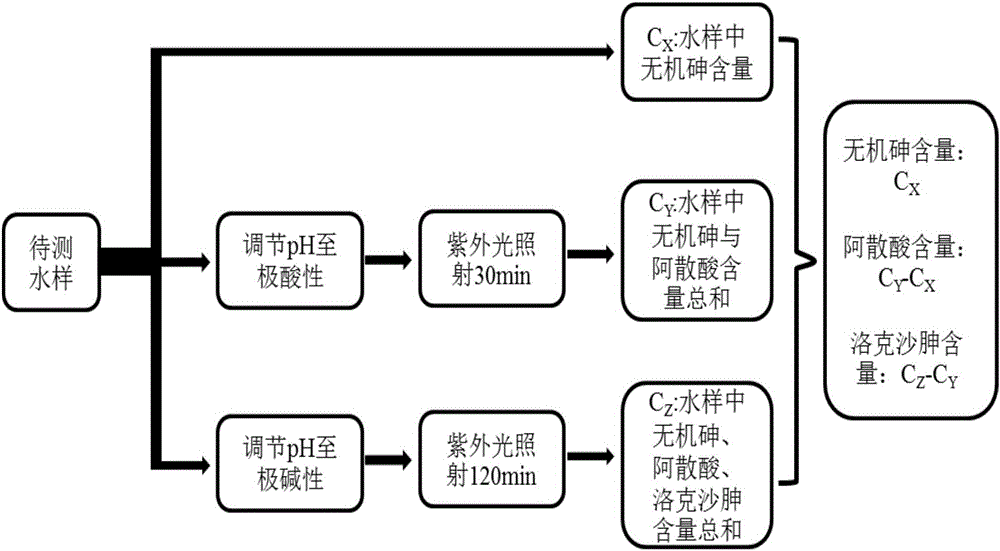Method for rapidly detecting arsanilic acid and roxarsone in water sample
A technology for assimilates and water samples, applied in the field of pollutant detection, can solve the problems of high cost of analysis and testing, expensive instruments, and high prices of consumables, and achieve the effect of improving detection capability, improving detection accuracy, and high test accuracy.
- Summary
- Abstract
- Description
- Claims
- Application Information
AI Technical Summary
Problems solved by technology
Method used
Image
Examples
Embodiment 1
[0027] Prepare 100 mL of simulated wastewater solution containing arsanic acid at a concentration of 5 μg / L.
[0028] ① Pipette 25 mL of water sample into a quartz reactor with a stopper, put in a stirring magnet for stirring, add 50 μL (1+1) HCl solution to make the solution strongly acidic, pass nitrogen into the quartz reactor for 10 minutes, and remove oxygen Afterwards, the stopper was plugged and sealed, and the reactor was placed under an ultraviolet disinfection lamp for irradiating for 30 minutes. Then take 4mL of the reacted sample into a 10mL sample tube filled with 0.5mL (1+1) hydrochloric acid, shake well, add 0.5mL 5%+5% thiourea+ascorbic acid (m / V), shake well again, After standing for half an hour, use atomic fluorescence detection, the measurement conditions are: the carrier is 5% HCl, the reducing agent is 0.5% KOH-2% KBH 4 , the carrier gas is high-purity argon (purity ≥ 99.999%). The measurement result was 4.019±0.180μg / L, that is, the total arsenic conce...
Embodiment 2
[0032] Prepare 100 mL of simulated wastewater solution containing roxarsone at a concentration of 5 μg / L.
[0033] ①Pipete 25mL of water sample into the quartz reactor with stopper, put it into the stirring magnet for stirring, add 50μL of 6M NaOH solution to make the solution strong alkaline, pass high-purity nitrogen into the quartz reactor for 10min, after deoxygenation , plugged the plug and sealed, and placed the reactor under the ultraviolet disinfection lamp for irradiating for 30 minutes. Then take 4mL of the reacted sample into a 10mL sample tube filled with 0.5mL (1+1) hydrochloric acid, shake well, add 0.5mL 5%+5% thiourea+ascorbic acid (m / V), shake well again, After standing for half an hour, use atomic fluorescence detection, the measurement conditions are: the carrier is 5% HCl, the reducing agent is 0.5% KOH-2% KBH 4 , the carrier gas is high-purity argon (purity ≥ 99.999%). The measurement result was 2.629±0.178μg / L, that is, the total arsenic concentration i...
Embodiment 3
[0037] Prepare 100 mL of mixed simulated wastewater solution containing 0.5 μg / L arkanic acid and 0.5 μg / L roxarsone.
[0038] ①Pipete 25mL water sample into the quartz reactor with stopper, put it into the stirring magnet for stirring, add 50μL of 6M NaOH solution to make the solution strong alkaline, pass nitrogen into the quartz reactor for 10min, after deoxygenation, Plug the stopper and seal it, and place the reactor under an ultraviolet disinfection lamp to irradiate for 120 minutes. Then take 4mL of the reacted sample into a 10mL sample tube filled with 0.5mL (1+1) hydrochloric acid, shake well, add 0.5mL 5%+5% thiourea+ascorbic acid (m / V), shake well again, After standing for half an hour, detect with atomic fluorescence. The measurement results showed that the total arsenic concentration in the water sample was 0.998±0.016μg / L, that is, the total organic arsenic content was 0.998±0.016μg / L.
[0039] ②Pipete 25mL water sample into the quartz reactor with stopper, put...
PUM
| Property | Measurement | Unit |
|---|---|---|
| Excitation wavelength | aaaaa | aaaaa |
Abstract
Description
Claims
Application Information
 Login to View More
Login to View More - R&D
- Intellectual Property
- Life Sciences
- Materials
- Tech Scout
- Unparalleled Data Quality
- Higher Quality Content
- 60% Fewer Hallucinations
Browse by: Latest US Patents, China's latest patents, Technical Efficacy Thesaurus, Application Domain, Technology Topic, Popular Technical Reports.
© 2025 PatSnap. All rights reserved.Legal|Privacy policy|Modern Slavery Act Transparency Statement|Sitemap|About US| Contact US: help@patsnap.com

